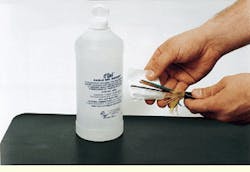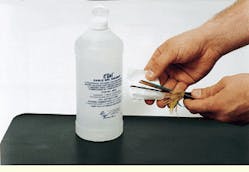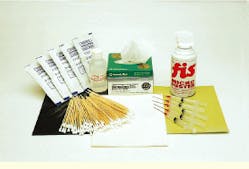Although chemicals and materials used in fiber optics are relatively common substances, they still require careful handling.
Laura Gribneau
Fiber Instrument Sales Inc.
Although chemicals may not commonly be associated with fiber optics, a large number of chemicals and other materials are used in the preparation, installation, and maintenance of fiber-optic systems. When using any chemicals, safety is a major concern. The chemicals used in the fiber-optics industry can range from benign, nontoxic substances, such as index-matching gel and cable-pulling lubricant, to highly dangerous hydrochloric and sulfuric acids. Many chemicals may be harmful if inhaled, ingested, or exposed to skin; some are flammable and may react with other substances.
Isopropyl alcohol
The most common of the chemicals associated with fiber optics are those used to prepare fiber before and during its termination to connectors. Typically, after stripping the jacket away from the cable, the technician uses a 99% reagent-grade isopropyl alcohol to clean the bare fiber of dirt and oils. This type of alcohol--also called isopropanol--is not found at the corner drugstore but is a specialty item sold through fiber-optic and laboratory-equipment supply companies. The alcohol comes in a variety of forms: a straight solution within a container, pre-moistened lint-free wipes, foam swabs that house the alcohol within a capillary that comprises the swab handle, and a canned aerosol spray. It is also frequently used to clean the endfaces of fiber-optic connector ferrules prior to testing, mating, or installation into a system and is, therefore, a standby in any maintenance-technician`s toolbox.
The 99% alcohol is highly combustible, volatile, and flammable. Improperly protected skin that is exposed to 99% alcohol will quickly dry out and become irritated. Inhalation of the vapors and overexposure to alcohol should be avoided at all costs, since prolonged exposure could result in kidney failure.
Solvents or cleaners
When preparing a gel-flooded, loose-tube cable before connectorization, a solvent-based cleaner must be used to remove the flooding compound from the fibers. These solutions--either a petroleum- or water-based product--are available in a container, a spray bottle, or pre-moistened wipes. They also remove grease, tar, oils, and dirt from hands, cables, tools, and equipment, so they are considered a relatively safe, multipurpose chemical.
Occasionally, acetone will be used as a solvent in the gel compound, but it is not considered as safe or effective as those chemicals specifically designed for this purpose. Acetone may also aid in the removal of adhesives and resins from tools used with fiber-optic epoxy.
Fiber-optic epoxies
An everyday item for cable-assembly technicians and installers is fiber-optic epoxy, which is used in the connectorization process to adhere the fiber within the ferrule. Varieties of epoxy are available in both one- and two-part packages (which are often conveniently premeasured), metal containers, and toothpaste-like tubes. Cure time and temperature vary according to the type of epoxy. Certain epoxies cure at room temperature, while others must be exposed to a heat source to set.
Anaerobic epoxies cure only in the absence of air, and ultraviolet (UV) epoxy must be exposed to UV light, as opposed to heat, in order to cure. Most fiber-optic adhesives must be applied to the fiber manually or injected into the back body of the connector, but some fiber-optic connectors contain a pre-injected epoxy. These connectors must be heated to soften the epoxy so that the fiber may be inserted; afterward, the epoxy cures as it cools.
With such a variety of products to choose from, one must take into consideration cost, ease of use, pot life, cure time, cure temperature, compatibility with connector styles and brands, and environmental requirements before deciding which epoxy is best for an application. Additional considerations are the epoxy`s requirements for an oven, light source, or other special tools.
Several epoxies on the market that are labeled as hazardous and volatile have been known to cause severe allergic reactions and thermal burns to the skin of some individuals. Certain epoxies emit harmful vapors and are flammable. Anaerobic epoxies have the potential to instantly bond skin on contact, much like the "super glues" available commercially. Epoxies that contain dyes may stain clothing permanently. If you get one of these epoxies on your skin, you can expect to live with the stains for days or even weeks.
Acids
Stripping away the buffer material from optical fiber normally requires the use of standard stripping tools. However, certain cables have buffers and coatings made of nonstandard materials that are often very brittle, strongly adhere to the fiber and, hence, very difficult to strip by mechanical means. Occasionally, hydrochloric acid, sulfuric acid, or other strong chemicals must be employed to completely remove coatings from fiber without damaging the optical glass. The acid works by dissolving the coating from the glass. Here again, acetone may be used to dissolve fiber coatings, but it may not be effective on the very stubborn varieties.
Extreme caution must be used when dealing with hydrochloric acid because it causes severe burns and is fatal if ingested or inhaled. Acetone is known to "eat" through plastics, textiles, wood, and other surfaces and is an irritant to the skin as well. Acetone is classified as a flammable liquid.
Polishing materials
Once a fiber-optic connector has been terminated and cured, the technician will polish the ferrule to remove the fiber "nub" that is left behind after scribing and to impart a finish to the connector endface. Polish films are available as a sheet of plastic coated on one side with aluminum oxide, silicon carbide, or diamond particles. The particles act as an abrasive and typically range from 0.05 micron to 15 microns. Each size particle performs a special function in the polishing process. Typically, the polish films containing the larger particles are used to rough in the connector by removing the fiber nub and any epoxy residue remaining on the ferrule. The smaller grit sizes enable the connector to achieve different levels of performance based on the thoroughness of the polish. Polish extenders are sometimes used to enhance the resulting finish of a connector, much like the wet-sanding process often used on wood. These substances are nonhazardous and contain what are classified as proprietary liquids.
Another material used in the polishing process is polish slurry, which can be likened to polish film in liquid form. It is composed of aluminum oxide, silicon carbide, or diamond particles suspended in a liquid as opposed to being adhered to a sheet of plastic. The slurry is often used with a polish machine to achieve special finishes that result in low insertion loss and low backreflection.
Polish films and slurries are generally safe to work with. However, prolonged exposure to the particle dust produced by films during the polishing process or in suspensions after the liquid has evaporated could result in minor respiratory irritation.
Index-matching material
Optical couplant, or index-matching material, is a silica-based gel or liquid used on connector endfaces and more commonly within mechanical splices to reduce Fresnel reflections. This grease-like compound has a refractive index very close to that of optical glass and therefore has the ability to reduce optical loss in connectors and splices. Typically supplied in a small plastic pot but also available in a more viscous form supplied in a syringe, optical couplant is frequently used to replenish the contents of mechanical splices during reuse.
Canned air
Canned air, frequently used to clean connector bodies prior to termination and to spray dirt and debris away from components such as mating sleeves, may not initially be considered a chemical due to the nature of its name. But the main ingredient of canned air is tetrafluoroethane, a chemical, indeed. Skin brought in contact with canned air will freeze instantly. The vapor is also harmful, and its effects range from slight dizziness to unconsciousness and even cardiac arrest.
Cable-pulling lubricants
A common chemical in the outside-plant environment is cable-pulling lubricant. Typically, such a lubricant is a water-based liquid used to reduce the friction within a duct or conduit while pulling fiber-optic, coaxial, and twisted-pair cable. The lubricant has no damaging effects on the cable-jacket material and provides a lubricating residue well after its water base has evaporated.
Shipping and transport of chemicals
When users are ordering any chemicals from a supplier, they should take into account any shipping restrictions, which may limit available quantities or affect transit time. For example, transport companies such as United Parcel Service and Federal Express deem hazardous a wide variety of chemicals used in fiber optics. Therefore, these companies have stringent regulations when it comes to the transportation of such materials. In most cases, hazardous materials are restricted from air transport. Alcohol and canned air are considered flammable and, therefore, are limited to ground shipment only. (In 1996, the explosion of oxygen canisters aboard ill-fated ValuJet 592 caused that airplane to crash.)
In the transport of chemicals, carriers also typically limit the quantity to be shipped, depending on the nature and properties of the chemicals themselves. Transport of the hazardous chemicals also requires strict adherence to documentation and labeling requirements. A package containing any hazardous chemical may be required to have several labels placed conspicuously on the outside of the container. In most cases, documentation in addition to standard shipping forms must be completed by the shipper and reviewed by the carrier.
With current shipping regulations, it becomes more and more difficult for suppliers to offer these types of chemicals. The number of companies dedicated to offering these materials is slowly dwindling, in many cases because they cannot justify the additional effort and expense it takes to ship them.
Technological advances
New fiber-optic epoxies hit the market virtually daily, promising advantages, cost savings, and user-friendliness. Some developments in epoxy composition offer such benefits as faster cure times, elimination of ovens or other expensive tools, and longer shelf lives. One epoxy in particular--an acrylic-based adhesive--offers a fast cure time without the need for an oven or special light and also has a pot life almost twice as long as traditional anaerobic epoxies. This type of adhesive allows the user more time to work with the epoxy before it cures. The epoxy is also reported to withstand exposure to environmental extremes better than most epoxies on the market.
A duct lubricant was recently introduced as a prelubricant. This product is designed to lubricate the interior wall of duct while in the field and promises to offer a cost savings over factory-lubricated ducts. This lubricant is also recommended for use with air-blown fiber and is suitable for the traditional methods of pulling or pushing cable.
New lubricants also have been developed to withstand temperature extremes. A new antifreeze gel can be pumped into conduits to surround the fiber-optic cable, preventing water permeation, ice formation, and subsequent fiber failure.
Chemicals definitely have their place in fiber optics. As new products are developed, they will inevitably pose risks for which we must be armed with safety information. Use workplace chemicals as directed, respect them, and you will continue to reap their full benefits.
A solvent removes gel from loose-tube cable.
A fiber-optic consumable kit contains epoxy, alcohol, canned air, polish film, epoxy syringes, lint-free tissues, and cotton swabs.
Laura Gribneau is international sales manager at Fiber Instrument Sales Inc. (Oriskany, NY--www.fisfiber.com). She can be contacted at (315) 736-2206, ext. 142 or e-mail: [email protected].


